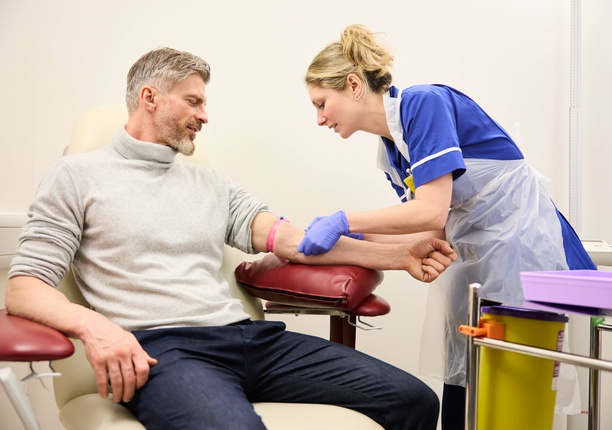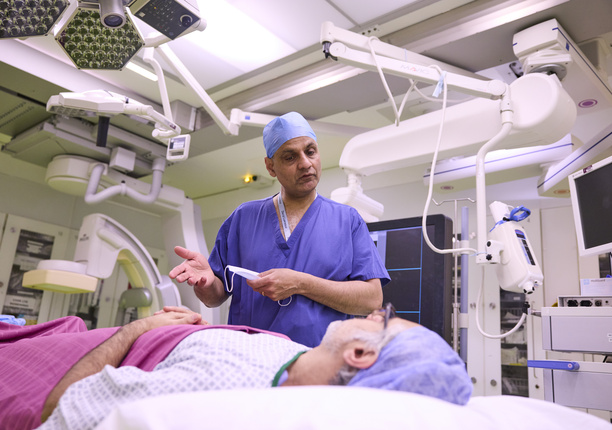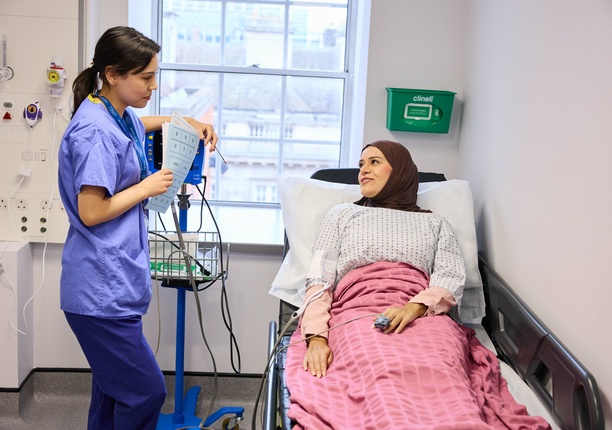Video-assisted thoracoscopy and mediastinoscopy
Video-assisted thoracoscopy (VATS) and mediastinoscopy are surgical techniques used to diagnose and treat various chest conditions, including lung cancer. At The London Clinic Lung Centre, our team of leading thoracic surgeons combine cutting-edge VATS and mediastinoscopy technology with renowned surgical expertise to deliver world-class results.
What are VATS and mediastinoscopy?
VATS and mediastinoscopy are minimally invasive surgical procedures. They each use a slightly different approach to enable a surgeon to visualise and operate on the lungs.
Video-assisted thoracoscopy (VATS)
During VATS, a small camera called a thoracoscope is inserted into the chest through small incisions in the chest wall. The camera sends real-time images of the chest’s interior to a video monitor, guiding the surgeon throughout the procedure. For example, they may remove a tumour from the lung or collect tissue for a biopsy to enable the diagnosis of a chest condition.
Mediastinoscopy
A mediastinoscopy procedure involves using a tool equipped with a light and camera, called a mediastinoscope, to examine the mediastinum – the space between your lungs which contains your lymph nodes, heart, windpipe, food pipe and major blood vessels.
Your surgeon will insert the mediastinoscope through a small incision at the base of your neck. The camera will then send real-time images to a computer screen, allowing your surgeon to look for abnormalities that may indicate cancer and to collect tissue samples for biopsy.
Are there any risks associated with VATS and mediastinoscopy?
All surgical procedures carry risks. The risks associated with VATS and mediastinoscopy include:
- Bleeding
- Pneumonia
- Infection at the surgical site
- Damage to tissue or organs near the surgical site
- Blood clots
- Lung perforation
- Arrhythmias (abnormal heart rhythms)
- Air in the space between the lung coverings that causes the lung to collapse (pneumothorax)
- Air leakage from the lung
- Complications from general anaesthesia, such as nausea and vomiting
VATS and mediastinoscopy FAQs
Since these procedures use such small incisions, they usually offer the following benefits compared to open surgery, which requires one large incision:
- Quicker recovery time
- Reduced postoperative pain
- Lower risk of complications or infection
- Less risk of blood loss
- Shorter stay in hospital
You will not feel any pain during your procedure because of the general anaesthetic. However, you may experience some pain once the anaesthetic wears off. This will be managed with painkillers prescribed by your care team.
While both VATS and mediastinoscopy are minimally invasive surgical procedures, a mediastinoscopy specifically accesses the mediastinum (the space between the lungs) through a small incision in the neck, while VATS provides a broader view of the chest’s interior.
Step 1. Preparing for VATS and mediastinoscopy
To determine if you are an ideal candidate for VATS or mediastinoscopy for lung cancer, you may need to undergo certain tests, such as:
- Blood tests to assess your overall health
- Imaging tests (e.g. an X-ray, computed tomography [CT], positron emission tomography [PET] or magnetic resonance imaging [MRI] scan)
- Heart tests (e.g. electrocardiogram [ECG])
- Pulmonary function tests, to assess how well your lungs are working
Your consultant will give you a list of instructions ahead of your VATS or mediastinoscopy procedure. These may include:
- Stopping certain medications, such as blood thinners, vitamins and herbal supplements
- Quitting smoking
- Making sure you are in the best possible shape for your recovery by maintaining regular exercise and a balanced diet
- Stopping eating and drinking several hours before the procedure
- Arranging for someone to drive you home from the clinic
Step 2. During VATS and mediastinoscopy
When it’s time for your procedure, you will be given a general anaesthetic to put you to sleep, ensuring you don’t feel any pain. A breathing tube will be inserted into your throat, and any hair around the surgical area will be shaved.
Your surgeon will then make the necessary incisions in the correct location, depending on whether you are undergoing a VATS or mediastinoscopy. They will insert the thoracoscope or mediastinoscope and complete the procedure while you are asleep.
Finally, the incisions will be closed with stitches and covered with bandages to protect the wounds. The VATS procedure takes between two and three hours, while a mediastinoscopy usually lasts between 45 and 60 minutes.
Step 3. Recovery and aftercare
You will wake up in the recovery room and may feel drowsy and confused at first. Once you are fully awake, you will be transferred to your hospital room for monitoring and given pain medication. You may also be given a device called a spirometer, which will encourage you to breathe deeply and help prevent an infection.
For a mediastinoscopy, you will need to stay in the hospital for a few hours or potentially overnight. In the case of a VATS procedure, you may need to stay in the hospital for several days.
Once you are ready to leave the hospital, you will need someone to pick you up and drive you home. You will be sent home with medication to help ease any discomfort, but it is important to only take the medications prescribed to you, as some may increase the risk of bleeding.
You will likely still feel very tired and will need time to rest and recover. It may take several weeks before you feel like your normal self. Your care team will guide you on when it is safe to resume normal daily activities, such as driving and lifting heavy objects. Recovery time for a mediastinoscopy is typically shorter than for a VATS procedure.
You will need to return to the clinic for follow-up appointments to remove your stitches and monitor your recovery. These visits may also include discussing biopsy results, which could indicate the need for additional surgery or therapies.




